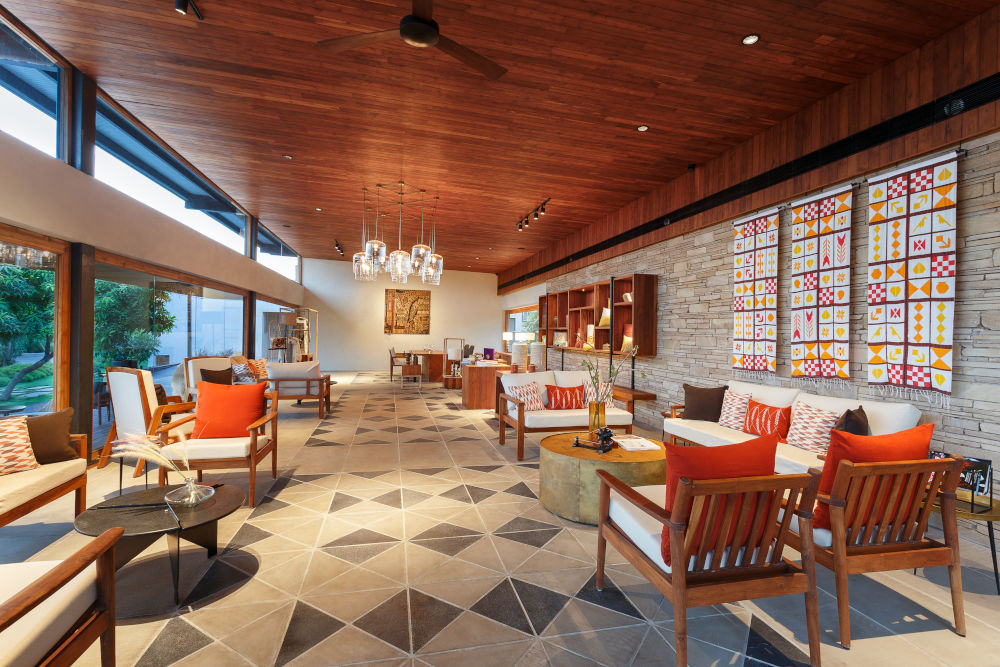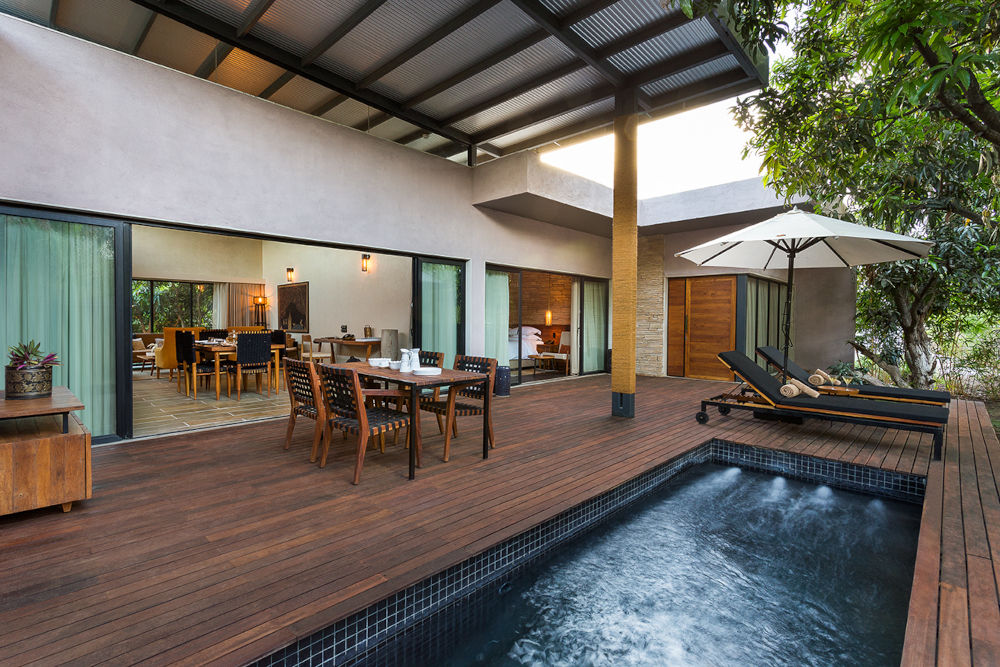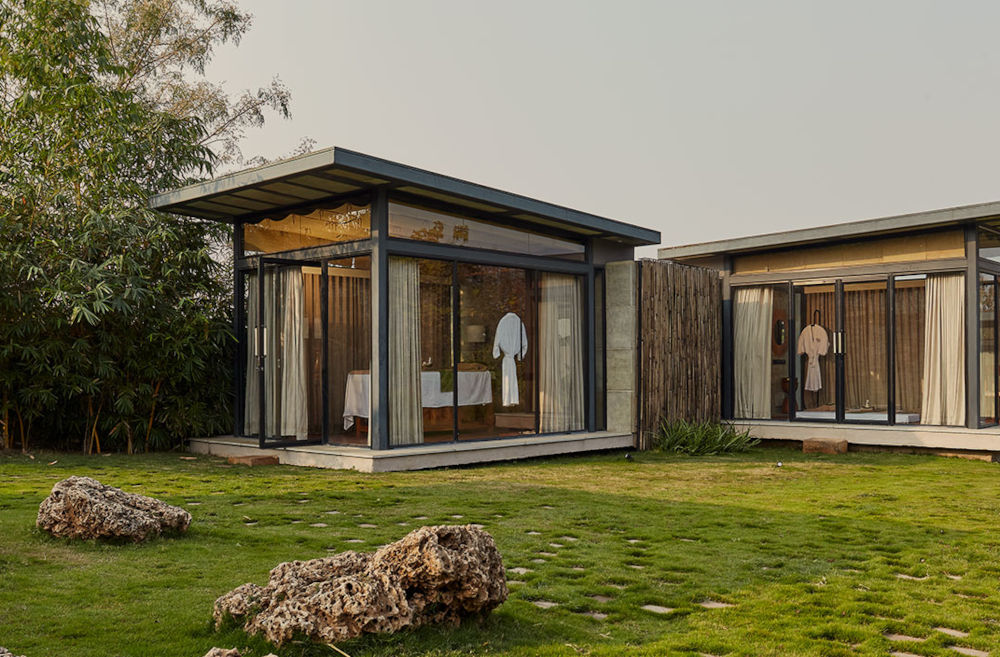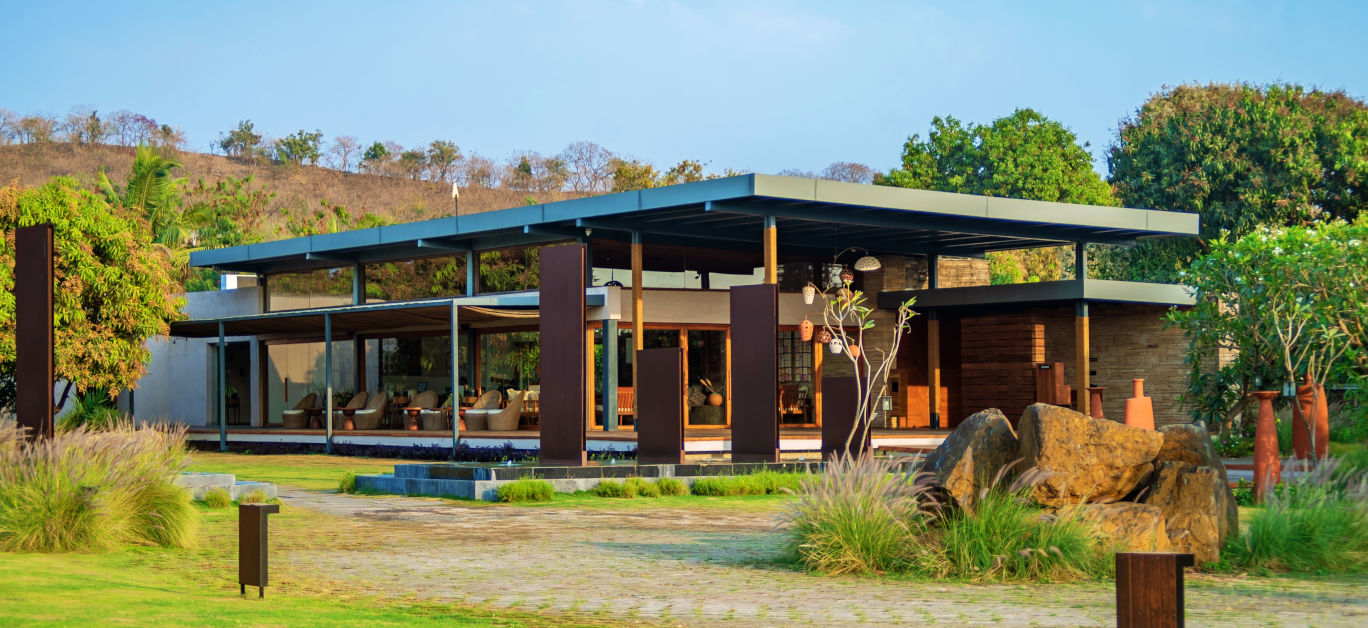Words by Veidehi Gite
In Gujarat’s Gir National Park, the final stronghold of Asiatic lions’ harmony between humans and wilderness unfolds, where the Maldhari tribe, guardians of tradition, share their land with these majestic predators.
31 kilometres from the emerald embrace of the Gir National Park, nature’s symphony spills into eco-conscious living at Woods At Sasan, each stone and beam an ode to sustainability. It makes you forget the frenetic city’s hum; helping you to unwind to the rhythm of a slower, greener dance. This sprawling five-star resort spans 16 acres, embracing a lush mango orchard with unparalleled respect. Remarkably, no trees were cut during construction – instead, 38 villas across four distinct categories were thoughtfully built within the existing space.
Hotel

A structure of clay lamps marks the entrance to the lobby of Woods at Sasan, embodying the biosphere of nature. “A small change,” emphasizes Nilay Saran, senior business director at 1000 Island Hotels, “and this delicate ecosystem could crumble.”
Earthen elegance meets reclaimed artistry at Woods at Sasan. Walls stand tall in the time-honoured Todi style, stones stacked raw and strong, echoing the village aesthetic. All the wood used here is reclaimed from the Alang shipyard on the Gulf of Khambhat, ensuring no new trees were cut down.
As you enter the lobby, a vibrant display unfolds: hand-crafted bags and delicious snacks, all made by local women of the Happy Faces organisation. Backed by 1000 Island Hotels, the parent company of WAS, this initiative breathes life into the cause by uplifting neighbouring villages, weaving a tapestry of empowerment and environmental responsibility. The interiors are embellished with beadwork, skilfully crafted by local artisans to resemble fabric. Adding to the ambience is a Pustakshala cabinet (library) that stands alongside paintings, and bronze utensils, offering a glimpse into the local culture and craftsmanship. Unmissable, near the reception, are three life-size artworks depicting the life cycles of stone, wood, and cotton.
“Our logo isn’t just a design; it’s a representation of our ethos. The lion embodies our commitment to preserving the natural world, while the mango tree reflects our focus on sustainable practices and a flourishing ecosystem,” says Nilay Saran. He adds, “As the sole Indian member of Regenerative Travels, a forward-thinking company committed to transformative travel experiences, we’re passionate about pushing beyond sustainable tourism. We are transitioning from sustainable practices to regenerative tourism: a philosophy focused on active renewal and growth. We are shortly launching Dirt-E Retreat, a unique experience within a four-acre food forest, where we have thoughtfully designed a retreat around our flourishing plantations.”
Room

Buildings are bad for the planet? Not at Woods At Sasan! They’re flipping the script, aiming for zero-carbon chill vibes with biophilic designs that blend seamlessly with nature. Think local materials, handcrafted magic, and spaces that hug your soul.
Peeking through the verdant canopy, each accommodation promises a unique experience. Wood Studios offers an intimate haven, while Wood Studios with Terrace provides an elevated escape with outdoor space. Woods Pavilion caters to shared moments, and the pinnacle of indulgence awaits at the sprawling Woods Villa with an indoor pool.
Crafted from the local Bela stone dressed to the nines in lime plaster, villas at Woods At Sasan effortlessly blend into the landscape. The interiors feature furniture fashioned from reclaimed wood, ceramics, bamboo accessories, and hand-dyed khadi furnishings lovingly curated by local artisans. Terracotta and macrame décor add a touch of bohemian charm, while the Pali bay window seating is inspired by the timeless allure of vernacular design. WAS ditches the fancy jargon and embraces simple, honest architecture that deepens your connection with the wild side.
Food and drink

When it comes to dining delights, Woods at Sasan doesn’t disappoint with its quartet of culinary havens. First up, there’s Terracotta, dishing out continental classics with flair. Then, for a taste of tradition, Swadesh beckons with its vegetarian Thali. Craving a slice of perfection? Head to Alfresco for wood-fired pizzas. And for a refreshing sip under the sun, Mango Bar has you covered with signature detox drinks, all served beneath the shade of a mango tree by the poolside.
At all restaurants, menus dance with the seasons, bursting with locally grown, organic ingredients sourced with the care of mindfulness. This means not only a lighter impact on the planet, but also a kaleidoscope of flavours for your palate. Think farm-to-table freshness, slow-cooked goodness that melts in your mouth, and upcycled food waste that would make Grandma proud.
Spa and wellness

At SOM Wellness, ancient Indian wisdom meets the holistic trinity of mind, body, and spirit, nurturing your soul through a curated blend of Ayurveda, Yoga, and Inner well-being practices. Whether you’re craving balance through Ayurvedic treatments, centring with Naturopathy, deep tissue Swedish massages that work out the kinks, acupuncture sessions that hit all the right points, or sound therapy, they’ve got holistic wellness covered. Vanaushadhi therapy is their ode to the healing wonders of the forest, where they use freshly ground herbal powders and oils, lovingly concocted from aromatic herbs and potent healing plants grown right at the resort.
I indulged in the one-hour ‘Abhyanga’ experience, an Ayurvedic ritual that takes you on a journey from head to toe. The warm herb-infused oil, tailored to your Dosha, gently caresses every inch of your body in the direction of arterial flow. The result? A symphony of benefits. Improved blood circulation? Check. Relief from pesky pains and stiffness? Absolutely. And let’s not forget the ultimate perk: stress relief that leaves you feeling as light as a feather.
“Abhyanga works its magic on your body’s energy, rebalancing elusive Doshas and leaving you with a sense of inner harmony that lingers long after the massage is over. Today we have used Ksheerabala oil; this relaxing oil for Padabhyanga will calm your senses, promoting restful sleep by balancing the deranged Vata dosha,” asserted Sharanya M, the seasoned Ayurvedic therapist of Woods at Sasan.
Sustainability and community engagement practices

When it comes to farming, Woods At Sasan serves up self-sufficiency with a side of biodiversity. It’s a mango fiesta with 280 trees in attendance. Native and exotic fruits mingle, flowers unfurl their vibrant flags, and vegetables do their jig. The retreat isn’t just about pretty landscapes; it acknowledges the importance of diverse plant species, pollinators, birds, animals, and soil microorganisms for thriving ecosystems. Various plant varieties attract bees, butterflies, and birds that rely on specific flowers and fruits for sustenance and specific trees for nesting. Even the tiniest critters get in on the soil shindigs.
Woods At Sasan is also dedicated to making a tangible difference in the lives of those around them. At the heart of their ethos lies a commitment to sustainable practices and responsible design. Through initiatives like Shramdaan, Swasthya Sewa, Samajik Granth Pariseva, and Krishi Utpadan, they’ve touched the lives of over 15,000 villagers across six nearby communities with 24 impactful programs addressing various social and environmental issues. They believe in leaving a positive footprint on the planet, which is why they’re constantly striving to implement initiatives that promote sustainable development and conserve resources for future generations. From supporting local communities to minimising environmental impact, Woods At Sasan is dedicated to building a better tomorrow, one thoughtful initiative at a time.
To do

Staying at Woods at Sasan means embarking on a journey of discovery right at your doorstep. When you find yourself in Sasan, embarking on a safari through Gir National Park is an absolute must-do. With nearly 600 lions roaming its vast expanse, this National Park is a testament to the Gujarat government’s dedication to conserving this iconic species, whose numbers dwindled due to hunting in the 19th century.
Trackers and guides play a crucial role, keeping a keen eye out for signs of wildlife activity, from fresh pug marks to the warning calls of nearby animals. The best time to visit is in March, just as winter gives way to the gentle embrace of spring. To embark on this adventure, permits are a must and can be obtained from the official Gujarat government website. With permits in high demand, it’s wise to book well in advance to secure your spot.
For those itching for nearby adventures, Junagadh beckons with its rich tapestry of history and architecture. Dive into the past with a visit to the 1892 Mahabat Maqbara, where Indo-Islamic styles mingle with European influences in a mesmerising blend of cultures. Marvel at the intricate carvings, onion-shaped domes, French windows, and silver doorways that adorn this architectural wonder.
But the exploration doesn’t stop there. Built by Chandragupta Maurya around 320 BC, Uparkot Fort, standing tall at the foothills of Girnar Hill, offers a glimpse into ancient times with walls that soar up to 20 meters high. After eight years of closure for renovations, Uparkot Fort, renowned as one of India’s most haunted, has recently reopened its doors to visitors just four months ago.
Factbox
Address: Gir Forest,India, Sasan-Talala Hwy, Sasan, Borvav, Gujarat 362135, India
Phone: +91 87581 00055
Website: woodsatsasan.com
Photography courtesy of Woods at Sasan.






















